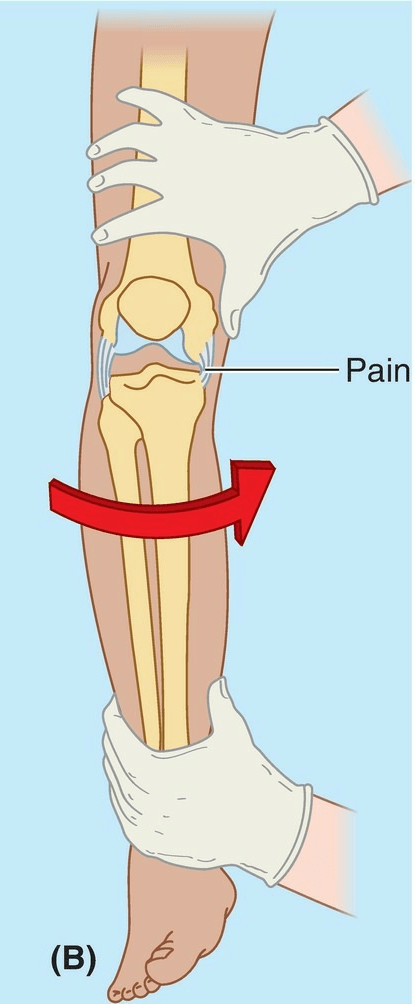Meniscal Tears
content of this page
1- Introduction
2- Anatomical Overview
3- Causes
4- Treatment
Introduction
Meniscal tears are common knee injuries that can significantly impact mobility and quality of life. The menisci are C-shaped pieces of cartilage located between the thigh bone (femur) and the shin bone (tibia) in each knee joint. Their primary role is to act as shock absorbers, cushioning the joint and stabilizing it during movements.

Anatomical Overview
Meniscal tears usually involve the medial meniscus. The lateral meniscus does not usually tear because of its mobility. Pain on lateral rotation of the tibia on the femur indicates injury of the lateral meniscus, whereas pain on medial rotation of the tibia on the femur indicates injury of the medial meniscus. Most meniscal tears occur in conjunction with TCL or ACL tears. Peripheral meniscal tears can often be repaired, or they may heal on their own because of the generous blood supply to this area. If tears do not heal or cannot be repaired, the meniscus is removed (e.g., by arthroscopic surgery). Knee joints from which a meniscus has been removed suffer no loss of mobility; however, the knee may be less stable and the tibial plateaus often undergo inflammatory reactions.

Causes
Traumatic Injury: Meniscal tears often result from sudden twisting or rotating movements of the knee joint under weight-bearing conditions. This can happen during sports activities that involve pivoting, cutting, or sudden stops and turns, such as soccer, basketball, football, and skiing. Direct trauma to the knee, such as a tackle or collision, can also cause meniscal tears.
Degenerative Changes: As people age, the menisci can weaken and become more prone to tears due to degenerative changes in the knee joint. This includes wear and tear over time, which can gradually weaken the meniscal tissue, making it more susceptible to tearing with minor trauma or even normal activities.
Overuse or Repetitive Stress: Activities that involve repetitive squatting, kneeling, or heavy lifting can stress the menisci and lead to tears over time. This is particularly common in occupations or sports that require frequent bending and twisting of the knee joint.
Poor Biomechanics: Issues with knee joint alignment or muscle imbalances can place abnormal stress on the menisci, increasing the risk of tears. For example, conditions like bowlegs (genu varum) or knock-knees (genu valgum) can alter the distribution of forces across the knee joint, potentially leading to meniscal injuries.
Previous Knee Injuries: Individuals who have previously experienced knee injuries, such as ACL tears or other ligament injuries, may be at higher risk for developing meniscal tears. These injuries can alter knee joint mechanics and increase the likelihood of meniscal damage during subsequent activities.
Aging and Wear and Tear: The menisci naturally degenerate with age, becoming less flexible and more prone to tearing. This process can be accelerated by factors such as obesity, which increases the load on the knee joint and accelerates joint degeneration.
Treatment
Conservative Treatment:
- Rest and Activity Modification: Avoiding activities that aggravate symptoms and allowing the knee to rest can help reduce pain and inflammation.
- Ice Therapy: Applying ice to the knee can help alleviate pain and swelling. It’s typically recommended to apply ice for about 15-20 minutes every few hours during the acute phase of injury.
- Pain Management: Over-the-counter pain relievers such as ibuprofen (Advil, Motrin) or acetaminophen (Tylenol) may be used to manage pain and inflammation.
- Physical Therapy: A structured physical therapy program can help strengthen the muscles around the knee joint, improve flexibility, and restore normal movement patterns. Therapists may use techniques such as ultrasound, electrical stimulation, and specific exercises to promote healing and reduce symptoms.
Surgical Treatment:
- Arthroscopic Surgery: For more significant tears that cause persistent symptoms or mechanical issues (such as locking or catching in the knee), surgical intervention may be necessary. Arthroscopic surgery is a minimally invasive procedure where small incisions are made around the knee joint, and a tiny camera (arthroscope) is inserted to guide surgical instruments. Depending on the nature of the tear, the surgeon may either repair the torn meniscus by stitching it back together or remove the damaged portion (partial meniscectomy).
- Meniscal Repair: Repairing the meniscus is typically preferred in younger patients with tears located in the outer portion of the meniscus, where there is good blood supply. This procedure aims to preserve the meniscus and its function.
- Meniscectomy: If the tear is in an area with poor blood supply or is not amenable to repair, the surgeon may perform a partial meniscectomy, where the torn portion of the meniscus is trimmed away. This procedure helps relieve symptoms but removes part of the meniscus, which can potentially increase the risk of developing arthritis in the future.
- Rehabilitation after Surgery: Following surgical intervention, rehabilitation plays a crucial role in recovery. Physical therapy focuses on restoring knee strength, range of motion, and functional stability. The rehabilitation program is tailored to the individual’s specific surgical procedure and recovery progress.
Injection Therapies:
- In some cases, injections of corticosteroids or hyaluronic acid (viscosupplementation) into the knee joint may be used to provide temporary relief of pain and inflammation, particularly for individuals who are not surgical candidates or are awaiting surgery.